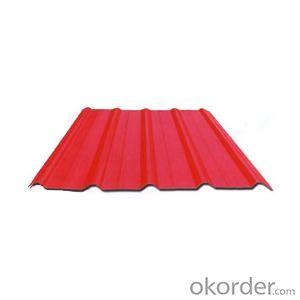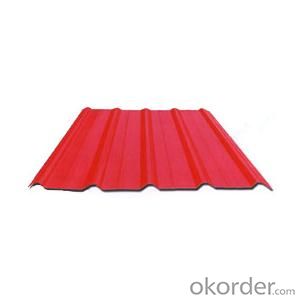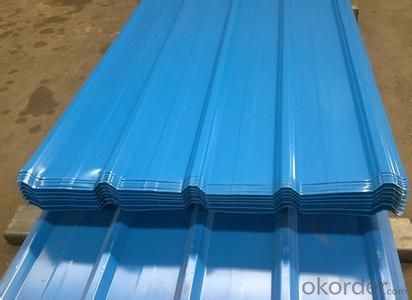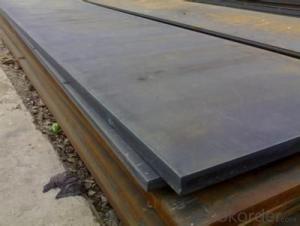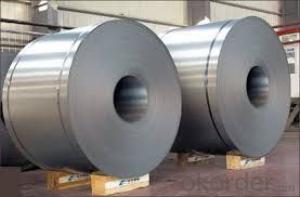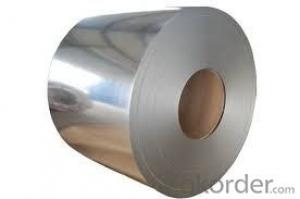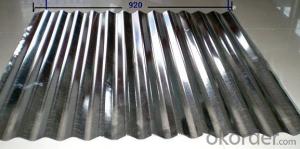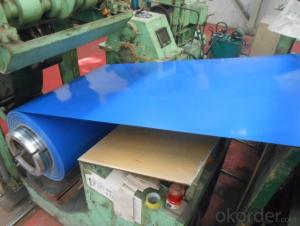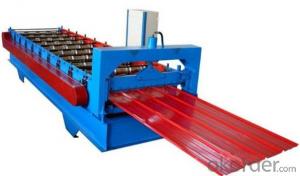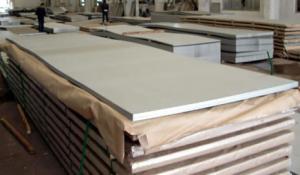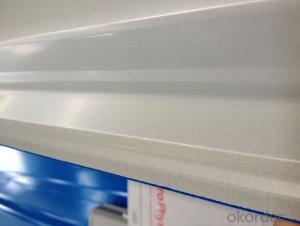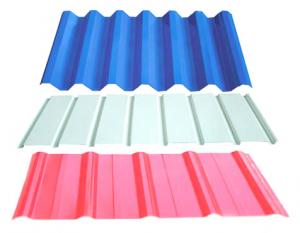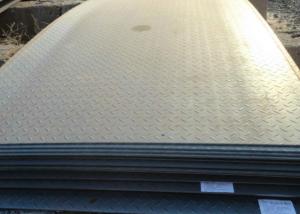PRE-PAINTED GALVANIZED STEEL CORRUGATED SHEETS
- Loading Port:
- Tianjin
- Payment Terms:
- TT OR LC
- Min Order Qty:
- -
- Supply Capability:
- 10000 m.t./month
OKorder Service Pledge
Quality Product, Order Online Tracking, Timely Delivery
OKorder Financial Service
Credit Rating, Credit Services, Credit Purchasing
You Might Also Like
PRE-PAINTED GALVANIZED STEEL CORRUGATED SHEETS
THICKNESS:0.25mm/0.27mm/0.30mm
WIDTH:820mm (0/+5mm, AFTER CORRUGATION)
LENGTH:3000mm (0/+5mm), 5800mm (0/+5mm)
ZINC COATING:80g/m2
STANDARD:JIS G 3312, CGCC (SOFT QUALITY)
TOP COATING:5+15 MICRON(POLYESTER); BACK COATING:5-7 MICRON (EPOXY),LIGHT GREY
COLOR:RAL3013 (RED TOMATO)
PACKAGE WEIGHT:3-5 tons
SPE:
| 0.25*820mm*3000mm (167-171 pcs) | ||
| 0.27*820mm*5800mm (79-83 pcs) | ||
| 0.30*820mm*5800mm (71-75 pcs) |
PROFILE IS ATTACHED TO BE CONFIRMED

- Q: Can steel sheets be used for making shipping containers?
- Steel sheets are indeed suitable for the construction of shipping containers. In reality, steel is the preferred material for building shipping containers because of its robustness, durability, and ability to withstand diverse weather conditions and environmental elements. Typically, steel sheets are cut, bent, and welded together to create the walls, roof, and floor of the container. This construction technique guarantees the container's strength and ability to endure the challenges of transportation, such as stacking, lifting, and exposure to harsh marine environments. Moreover, steel containers can be easily tailored and adjusted to fulfill specific requirements for storing and transporting cargo.
- Q: What is the difference between a perforated and expanded steel sheet?
- A perforated steel sheet and an expanded steel sheet are both types of metal sheets commonly used in various industries. However, they differ in terms of their manufacturing process and resulting characteristics. Perforated steel sheets are created by punching or drilling holes into a solid steel sheet. These holes can be of various shapes, sizes, and patterns, depending on the desired application. The holes in a perforated steel sheet allow for the passage of air, light, sound, or fluids, making them suitable for applications that require ventilation, filtration, or acoustic properties. Perforated steel sheets are commonly used in industries such as architecture, automotive, filtration, and mining. On the other hand, expanded steel sheets are produced by a unique manufacturing process known as expanding. The process involves cutting and stretching a solid steel sheet, resulting in a mesh-like pattern with diamond-shaped openings. The stretching process imparts strength and rigidity to the steel sheet while also reducing its weight. Expanded steel sheets are versatile and can be used in applications such as walkways, platforms, fencing, grating, and reinforcement. In summary, the main difference between a perforated and expanded steel sheet lies in their manufacturing process and resulting characteristics. Perforated steel sheets have holes punched or drilled into them, allowing for the passage of air, light, sound, or fluids. Meanwhile, expanded steel sheets are created by cutting and stretching a solid sheet, resulting in a mesh-like pattern with diamond-shaped openings. Both types of sheets have their unique advantages and are chosen based on the specific requirements of the application.
- Q: How are steel sheets packaged for shipping?
- Typically, steel sheets are packaged in a manner that guarantees their protection during transportation. This is achieved through a series of steps aimed at preventing any damage or deformation that may occur during transit. To start, the steel sheets are commonly stacked on wooden pallets or placed in sturdy steel crates. This serves to create a stable base and prevents any movement or shifting of the sheets during transportation. Additionally, the use of pallets or crates facilitates the loading and unloading of the sheets onto trucks or containers. To further safeguard the steel sheets from scratches or other forms of surface damage, they are often wrapped with a layer of protective material. This can include plastic wraps, paper or cardboard interleaves, or even an application of oil or rust inhibitor. These protective materials act as a barrier, preventing any direct contact that could potentially cause scratches. Furthermore, steel sheets may be securely bundled together using steel strapping or wire. This bundling process helps to maintain the structural integrity of the sheets and prevents them from shifting or sliding during transportation. Lastly, once the steel sheets are appropriately packaged, they are typically labeled with pertinent information such as product specifications, quantity, and destination. This ensures ease of identification and proper handling at each stage of the shipping process. In summary, the packaging of steel sheets for shipping is meticulously carried out to ensure their safe and secure transportation. By utilizing pallets or crates, protective materials, bundling, and labeling, steel sheets can withstand the demands of shipping and reach their destination in optimal condition.
- Q: Can steel sheets be used for roofing purposes?
- Yes, steel sheets can be used for roofing purposes. Steel roofing sheets are commonly used in commercial and industrial buildings, as well as residential homes. They are known for their durability, longevity, and resistance to harsh weather conditions such as rain, snow, and wind. Steel sheets are available in various profiles and finishes, allowing for customization to suit different architectural styles and design preferences. Additionally, steel roofing is lightweight, fire-resistant, and often made from recycled materials, making it an environmentally friendly roofing option. Overall, steel sheets are a popular choice for roofing due to their strength, versatility, and aesthetic appeal.
- Q: What is the difference between a galvanized and stainless steel sheet?
- Both galvanized and stainless steel sheets are utilized in various applications, but there are notable distinctions between the two materials. One significant difference is their resistance to corrosion. Galvanized steel sheets are coated with zinc to shield them from rust and corrosion, making them ideal for outdoor applications or environments with high humidity or moisture. Conversely, stainless steel sheets are composed of chromium and other alloys, granting them superior corrosion resistance. They can endure exposure to chemicals, acids, and saltwater, making them suitable for highly corrosive environments. Another disparity lies in their appearance. Galvanized steel sheets possess a characteristic silver-gray color due to the zinc coating. Over time, the zinc coating can acquire a dull, weathered appearance. In contrast, stainless steel sheets possess a distinct, shiny appearance that can vary based on the applied finish. This makes stainless steel sheets more visually appealing and suitable for applications where aesthetics matter. In terms of strength and durability, stainless steel sheets tend to surpass galvanized steel sheets. Stainless steel has a higher tensile strength, enabling it to withstand more force or pressure before breaking. Additionally, stainless steel is more resistant to dents and scratches compared to galvanized steel. Cost is another factor to consider when choosing between galvanized and stainless steel sheets. Generally, galvanized steel sheets are more cost-effective than stainless steel sheets. This makes them a viable option for applications where corrosion resistance is not of utmost importance. Conversely, stainless steel sheets are pricier due to the higher cost of raw materials and the additional processing required to create the stainless steel alloy. To summarize, the main distinctions between galvanized and stainless steel sheets lie in their corrosion resistance, appearance, strength, and cost. Galvanized steel sheets offer decent corrosion resistance at a lower cost, while stainless steel sheets provide superior corrosion resistance, strength, and a more appealing appearance at a higher price point.
- Q: Can steel sheets be used for transportation equipment?
- Yes, steel sheets can be used for transportation equipment. Steel is a widely used material in the transportation industry due to its strength, durability, and cost-effectiveness. Steel sheets are commonly used in the construction of various transportation vehicles such as cars, trucks, buses, trains, ships, and airplanes. They can be used for the body panels, chassis, frames, and other structural components of these vehicles. Steel sheets offer excellent mechanical properties, including high tensile strength and impact resistance, making them suitable for withstanding the stresses and demands of transportation applications. Additionally, steel is also known for its ability to be easily formed and welded, allowing manufacturers to create complex shapes and structures required for transportation equipment.
- Q: What's the difference between hot-rolled seamless steel tube and cold-rolled seamless steel tube?
- Cold rolled seamless steel pipe (DIAL) in general, steel pipe for low and medium pressure boiler tube, high-pressure boiler steel pipe, alloy steel pipe, stainless steel pipe, oil cracking tube and other steel tube, including carbon thin-walled steel, alloy thin-walled steel, stainless steel, thin steel tube.
- Q: Can steel sheets be used for bridge construction?
- Yes, steel sheets can be used for bridge construction. Steel is a widely used material in bridge construction due to its strength, durability, and ability to withstand heavy loads. Steel sheets are often used to create the structural framework of bridge beams and girders, providing the necessary support for the bridge's weight and traffic. Additionally, steel sheets offer flexibility in design, allowing for different shapes and sizes to meet specific bridge requirements. Overall, steel sheets are a popular choice in modern bridge construction due to their reliability and cost-effectiveness.
- Q: Can steel sheets be used in aerospace applications?
- Yes, steel sheets can be used in aerospace applications. While steel is not as commonly used as other materials like aluminum or titanium in aerospace, it can still be employed in certain specific applications such as structural components or engine parts where its high strength, durability, and resistance to extreme temperatures are beneficial.
- Q: How do steel sheets perform under heavy loads or pressure?
- Steel sheets are designed to perform exceptionally well under heavy loads or pressure. Due to their high tensile strength and durability, steel sheets can withstand significant amounts of weight without bending or breaking. They offer excellent resistance to deformation and can maintain their structural integrity even when subjected to intense pressure. Hence, steel sheets are widely used in various industries for applications that require robust materials capable of bearing heavy loads or pressure.
Send your message to us
PRE-PAINTED GALVANIZED STEEL CORRUGATED SHEETS
- Loading Port:
- Tianjin
- Payment Terms:
- TT OR LC
- Min Order Qty:
- -
- Supply Capability:
- 10000 m.t./month
OKorder Service Pledge
Quality Product, Order Online Tracking, Timely Delivery
OKorder Financial Service
Credit Rating, Credit Services, Credit Purchasing
Similar products
Hot products
Hot Searches
Related keywords
